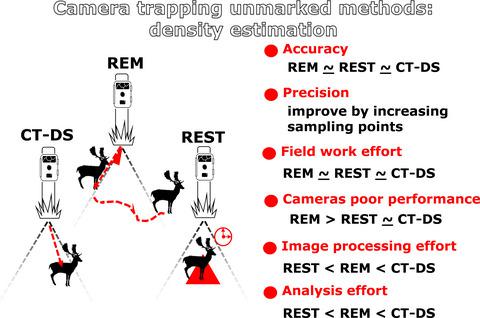当前位置:
X-MOL 学术
›
J. Appl. Ecol.
›
论文详情
Our official English website, www.x-mol.net, welcomes your feedback! (Note: you will need to create a separate account there.)
Assessing the camera trap methodologies used to estimate density of unmarked populations
Journal of Applied Ecology ( IF 5.7 ) Pub Date : 2021-05-17 , DOI: 10.1111/1365-2664.13913 Pablo Palencia 1 , J. Marcus Rowcliffe 2 , Joaquín Vicente 1 , Pelayo Acevedo 1
中文翻译:

评估用于估计未标记人群密度的相机陷阱方法
更新日期:2021-05-17
Journal of Applied Ecology ( IF 5.7 ) Pub Date : 2021-05-17 , DOI: 10.1111/1365-2664.13913 Pablo Palencia 1 , J. Marcus Rowcliffe 2 , Joaquín Vicente 1 , Pelayo Acevedo 1
Affiliation

|
- Population density estimations are essential for wildlife management and conservation. Camera traps have become a promising cost-effective tool, for which several methods have been described to estimate population density when individuals are unrecognizable (i.e. unmarked populations). However, comparative tests of their applicability and performance are scarce.
- Here, we have compared three methods based on camera traps to estimate population density without individual recognition: Random Encounter Model (REM), Random Encounter and Staying Time (REST) and Distance Sampling with camera traps (CT-DS). Comparisons were carried out in terms of consistency with one another, precision and cost-effectiveness. We considered six natural populations with a wide range of densities, and three species with different behavioural traits (red deer Cervus elaphus, wild boar Sus scrofa and red fox Vulpes vulpes). In three of these populations, we obtained independent density estimates as a reference.
- The densities estimated ranged from 0.23 individuals/km2 (fox) to 34.87 individuals/km2 (red deer). We did not find significant differences in terms of density values estimated by the three methods in five out of six populations, but REM has a tendency to generate higher average density values than REST and CT-DS. Regarding the independents’ densities, REM results were not significantly different in any population, and REST and CT-DS were significantly different in one population. The precision obtained was not significantly different between methods, with average coefficients of variation of 0.28 (REST), 0.36 (REM) and 0.42 (CT-DS). The REST method required the lowest human effort.
- Synthesis and applications. Our results show that all of the methods examined can work well, with each having particular strengths and weaknesses. Broadly, Random Encounter and Staying Time (REST) could be recommended in scenarios of high abundance, Distance Sampling with camera traps (CT-DS) in those of low abundance while Random Encounter Model (REM) can be recommended when camera trap performance is not optimal, as it can be applied with less risk of bias. This broadens the applicability of camera trapping for estimating densities of unmarked populations using information exclusively obtained from camera traps. This strengthens the case for scientifically based camera trapping as a cost-effective method to provide reference estimates for wildlife managers, including within multi-species monitoring programmes.
中文翻译:

评估用于估计未标记人群密度的相机陷阱方法
- 人口密度估计对于野生动物管理和保护至关重要。相机陷阱已成为一种很有前途的经济有效的工具,已经描述了几种方法来在个体无法识别时(即未标记的种群)估计种群密度。然而,它们的适用性和性能的比较测试很少。
- 在这里,我们比较了三种基于相机陷阱估计人口密度而无需个体识别的方法:随机遭遇模型 (REM)、随机遭遇和停留时间 (REST) 以及使用相机陷阱进行距离采样 (CT-DS)。在相互一致性、精度和成本效益方面进行了比较。我们考虑了六个密度范围广泛的自然种群,以及三个具有不同行为特征的物种(马鹿Cervus elaphus、野猪Sus scrofa和赤狐Vulpes vulpes)。在其中三个种群中,我们获得了独立的密度估计值作为参考。
- 估计的密度范围从 0.23 只/km 2(狐狸)到 34.87 只/km 2(马鹿)。我们在六个群体中的五个群体中没有发现三种方法估计的密度值存在显着差异,但 REM 有产生比 REST 和 CT-DS 更高的平均密度值的趋势。关于独立个体的密度,REM 结果在任何人群中都没有显着差异,而 REST 和 CT-DS 在一个人群中存在显着差异。方法之间获得的精度没有显着差异,平均变异系数为 0.28 (REST)、0.36 (REM) 和 0.42 (CT-DS)。REST 方法需要最少的人力。
- 合成与应用。我们的结果表明,所有检查的方法都可以很好地工作,每种方法都有特定的优点和缺点。从广义上讲,在高丰度的场景中可以推荐随机遭遇和停留时间(REST),在低丰度的场景中推荐使用相机陷阱的距离采样(CT-DS),而当相机陷阱性能不佳时可以推荐随机遭遇模型(REM)最佳,因为它可以以较小的偏倚风险应用。这扩大了相机陷阱的适用性,用于使用专门从相机陷阱获得的信息来估计未标记种群的密度。这加强了基于科学的相机诱捕作为一种具有成本效益的方法为野生动物管理者提供参考估计的方法,包括在多物种监测计划中。


























 京公网安备 11010802027423号
京公网安备 11010802027423号